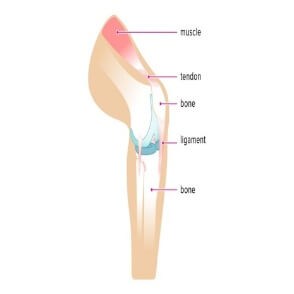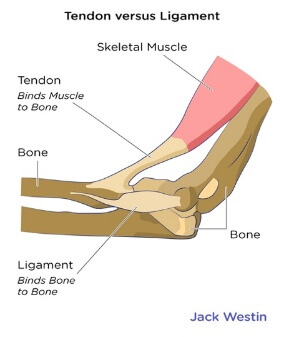Difference between Tendon and Ligament
The primary distinction between tendons and ligaments is that whereas ligaments join bones together, tendons join muscles to bones. Ligaments are referred to as connective tissues because they act like one. Cells that make up connective tissues' skeletal system are involved in these problems. In contrast to ligaments, which are robust and elastic, tendons are both strong and flexible. Living cells makeup both the joint tissue and the bone. For keeping joints and bones healthy, they are crucial. They contain collagen.

Ligament
Ligaments are the connective tissues that join two bones together. Lots of sturdy collagen fibres make up ligaments. In addition, ligaments are found in the body in a variety of shapes and resemble cords.
Tendon
Muscles and bones are connected by tendons, which are connective tissues. The tendon's function is to facilitate motion. They are not extremely elastic but are tear resistant.
Ligaments and tendons are components of the skeletal and muscular systems. These are the connective tissues that hold the body's various components together. Both tendons and ligaments are composed of collagen-containing living cells.
Structure of Tendon and Ligament
- Tiny fascicles can be seen inside tendons and ligaments.
- Each fascicle contains fibroblasts as well as the fundamental fibril of the tendons or ligaments.
- A fibroblast is a type of biological cell that produces tendons and ligaments.
- The crimp or waviness of the fibril plays a significant role in the nonlinear stress-strain relationship of ligaments and tendons.
- Most tissues, including tendons and ligaments, are composed of 70% water, 20% collagen, and 2% ground-up debris.
- However, collagen makes up 70% of its dry weight.
- Collagen is a protein that forms fibrils and raises tensile strength.
- Different ligaments and tendons have different patterns of collagen fibres.
- Ligaments are arranged into a thick, disorganised, and randomly packed network.
- Organized, parallel and linear arrangements characterise the tendon tissue.
- Because of this, tendons can endure large uniaxial (unidirectional) tensile loads during activity, as opposed to ligaments, which normally carry tensile loads in one direction and lower tensile loads in other directions.
Working of Tendon and Ligament
- Considering ligaments to be rope made up of a network of strong, tangled fibres that hold bones together. Ligaments also include a little number of elastic fibres, which allow the joint to move but not too far.
- For instance, the knee joint has four main ligaments: Two-run diagonally across the front and back of the kneecap, one on each side of the joint. These ligaments aid in knee stabilization and prevent excessive forward, backward, or side-to-side motion.
- Although they are less rigid than ligaments, tendons are nonetheless strong cords. The tendon that is attached pulls the bone into motion as the muscle contracts. Consider what occurs to your bicep when you bend.
Various Ligament Types
1. Articular Ligament
Different ligaments can restrict motion or activity at a joint. Part of an articular capsule, capsular ligaments are found in the area around synovial joints. Extracapsular ligaments are ligaments that connect to other ligaments to offer stability. Beyond what the less-than-joint ligaments can supply, the intracapsular ligaments add strength and range of motion.
2. Artificial Ligament
A piece of material that has been strengthened to replace a torn ligament is called an artificial ligament. A polymer, like PET or polyacrylonitrile fibre, is used to create this synthetic material. A broken ligament in the body most frequently occurs in the anterior cruciate ligament. An ACL injury necessitates reconstructive surgery since it is crucial for maintaining knee stability. One can replace a torn ligament using a variety of methods.
3. Fetal residual ligaments
When certain tubular foetal structures close and transform into cord-like structures, they become ligaments.
Structural Difference between Tendons and Ligaments

| Tendons |
Ligaments |
- They are located at the tips of skeletal muscles and link muscle to bone. These connective tissues also have fibrous structures.
- They have a stiff, rigid feel.
- Fibroblasts are abundant in tendons and are arranged in straight rows.
- In close parallel bundles, fibres are organised.
- They attach muscles to bones at their ends.
- Tendons are composed of white fibrous connective tissue.
- Within themselves, they are not classified.
- By connecting the thigh bone and shinbone, the anterior cruciate ligament, or ACL, stabilises the knee joint.
|
- They connect bones together throughout the body. That's why they can be found in the joints. They also allow for the movement of bones and are flexible.
- Both supple and robust, they
- In the ligaments, fibroblasts are found all around.
- Instead of being placed in parallel bundles, the fibres are tightly packed.
- Bones are joined together at joints.
- The structure of a ligament is a yellow-colored fibrous connective tissue.
- Peritoneal ligaments, articular ligaments, and ligaments of the foetus remnant make up their categorization into categories.
- Calf muscle to heel bone through Achilles tendon. Achilles tendon, is the largest tendon in our body.
|
Functional Difference between Tendons and Ligaments
| Tendons |
Ligaments |
- Tendons are essential for our body's movement because they transfer force from muscle to bone.
- Tendons cover the body from the head to the neck and all the way down to the feet.
- The force of a tendon can be up to five times that of our body weight.
- Overuse of certain body parts, such as our hands, biceps, shoulders, ankles, and knees, can result in tendonitis.
- Tendonitis is caused by an abrupt force that strains or ruptures tendon fibres.
- Cleaning, playing golf, throwing balls, having poor posture, exercising carelessly, and other activities can all contribute to this problem.
|
- Ligaments are specialized connective tissues with distinct biomechanical properties.
- Most ligaments are made up of collagen fibres.
- These fibres are extremely resistant to pulling or compressing pressures, as well as being flexible and strong.
- Individual collagen fibres' normal arrangement into parallel bundles increases their strength.
- Collagen bundles connect the periosteum. This outer layer protects all bones.
- When a ligament is injured, its structure and physiology are significantly altered.
- Scar tissue forms, which is less physiologic and biomechanically sound than the tissue it replaces.
|
Tendon Injuries
People who play sports frequently suffer from tendon injuries. Tendons are the root of 30 to 50 per cent of sports injuries. A strain that harms a tendon or the muscle to which it joins is a common sports injury. The pain from the injuries can be unbearable. The recovery from a significant strain might take a while.
When you fall or abruptly twist the tendon, a strain may develop. People who are not active may be more prone to injury, especially if they suddenly become active or because of inactivity and muscle weakness. Tendon injuries are regularly sustained by athletes. Thirty to fifty per cent of sports injuries involve tendons. A common sports injury is a strain that affects a tendon or the muscle to which it attaches. The injury could cause excruciating discomfort. After a significant strain, recuperation could take some time. A strain could happen if you fall or twist the tendon suddenly. Inactive people may be more likely to have an accident, especially if they suddenly start moving around or their muscles are already weak from inactivity.
- Tendonitis: Tendonitis is an inflammation of a tendon. Tendinitis can be brought on by trauma, such as a strain, although overuse injuries are the most common cause. Tendonitis patients may experience pain and swelling while touching the affected area. Tendinosis is like a muscular strain in that it develops over months or years because of overuse or poor sports technique.
- Subluxation: Subluxation happens whenever a tendon dislocates. A joint that has been wounded by something that snaps or pops could feel painful and numb. Every now and then, the pain changes. Although tendon snapping can come from an accident, subluxation is more likely to happen because of certain hereditary anatomical anomalies.
Treatment for Tendon and Ligament Injury
Treatment for injuries to tendons and ligaments is quite similar. They usually require rest, cold, compression, and elevation. If you have pain or swelling, make an appointment with your doctor for a precise diagnosis and an effective course of action. In the interim, physicians advise:
- Rest: Try to prevent your injured body part from moving until full healing has started. Crutches and immobilization braces may help with this process if necessary.
- Ice: To speed up healing, place an ice pack on the injured area for 20 minutes at a time, several times daily. The pack should be wrapped in a towel to prevent skin damage.
- Compression: To reduce edoema, apply a compression bandage. Make sure the bandage is tightly cinched without becoming so excruciatingly.
- Elevation: If you maintain the injured area of your body above your heart, it will heal more quickly.
- Medication: As needed, over-the-counter analgesics and painkillers may help you experience reduced swelling and discomfort.
|


 For Videos Join Our Youtube Channel: Join Now
For Videos Join Our Youtube Channel: Join Now










